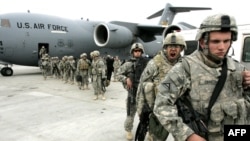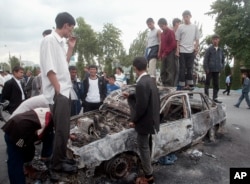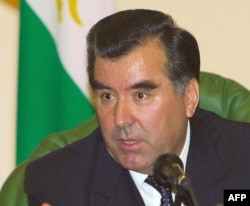Some recent media reports suggest the U.S. military will seek to reposition some of its troops in Central Asia after its big decision to withdraw from Afghanistan after nearly two decades in the country.
The New York Times reported on April 15 that U.S. officials had been in contact with Kazakh, Uzbek, and Tajik authorities about the possibility of using bases in the region.
And U.S. Secretary of State Antony Blinken said in tweets that he had spoken on April 22 with the Uzbek and Kazakh foreign ministers, though it's not known if they discussed the possible use of military bases by U.S. or other NATO troops.
If such a deal was made between Washington and Central Asian countries, it would not be the first time the region hosted U.S. and other NATO troops.
The last time Western troops used bases in Central Asia -- beginning in 2001 and lasting until 2014 -- it did not end so smoothly.
But there are still several good reasons for U.S. and NATO officials to talk to Central Asian countries about trying it again.
Been There Before
Shortly after the September 11, 2001, terrorist attacks by Al-Qaeda on the United States, Washington contacted officials in Kazakhstan, Kyrgyzstan, Tajikistan, Turkmenistan, and Uzbekistan to talk about a role for Central Asia in the upcoming U.S.-led military campaign in Afghanistan.
There were several reasons for the Central Asian governments to eagerly agree to help out.
With the exception of Turkmenistan, the other four countries had watched with growing concern as fighters from the fundamentalist Taliban movement swept from southeastern Afghanistan toward their countries.
Taliban forces reached the river town of Hairaton, just across the Amu-Darya from Uzbekistan, in August 1998. One month later they were in Sher Khan Bandar, just across the Pyanj River from Tajikistan.
There was also broad international support for the looming U.S. military campaign in Afghanistan, and the United States had been helpful to Central Asia throughout the 1990s.
The United States was, for example, among the first countries to recognize the independence of the five Central Asian states (in December 1991) and to establish diplomatic ties with them.
Washington's support for their sovereignty reassured the new governments that they were not solely bound to Moscow.
Also, with the exception of Tajik President Emomali Rahmon (known as Rahmonov until 2007), the Central Asian presidents were granted official visits to Washington in the 1990s. (Rahmon has still not had an official visit).
Furthermore, the United States was also the largest donor of humanitarian aid to Tajikistan during that country’s 1992-1997 civil war.
So the new Central Asian countries saw an opportunity for positive publicity with U.S. ties and, at the same time, concluded that cooperating with the United States and its Western allies could rid them of what they saw as a serious threat to the region -- Islamist fighters in Afghanistan.
The Situation Before 9/11
Security had become a big concern for Central Asia ever since the Taliban appeared on the region’s doorstep.
Turkmenistan abided by its policy of neutrality and managed to engage with various Afghan factions -- including the Taliban -- without committing to them or incurring their ire.
But Tajikistan and Uzbekistan supported formations under the command of their ethnic kin: the ethnic Tajik Afghan commander Ahmad Shah Masud and the ethnic Uzbek Afghan commander Abdul Rashid Dostum, respectively.
The Taliban even complained to the United Nations in March 1997 -- about one year after it took Kabul -- about rival Afghan military factions receiving help from Tajikistan and Uzbekistan, including the Tajik government allowing Masud to base warplanes in the southern Tajik city of Kulob.
The Tajik and Uzbek governments' active support of the Taliban’s opponents left open the possibility of the Islamist group or their followers attacking those countries.
When the Taliban captured Kabul in September 1996, there was a unity among Kazakhstan, Kyrgyzstan, Tajikistan, and Uzbekistan that has seldom been seen.
A common foe -- the Taliban and its Islamist ideology -- had brought them together.
By the summer of 2001, the Taliban controlled some 95 percent of Afghanistan.
That made the Kyrgyz, Tajik, and Uzbek governments amiable to allowing the United States and its allies to use their territory, including military bases, to wage a campaign against the Taliban and their terrorist friends.
U.S. forces deployed to the Khanabad base in Uzbekistan, the Bishkek airport in Kyrgyzstan, and briefly the airfield in Kulob, Tajikistan -- the same base where Masud had moved his warplanes.
NATO allies were also stationed in Central Asia.
Germany used a base near Termez, Uzbekistan, and French troops used the airfield outside the Tajik capital, Dushanbe.
The new cooperation paid off almost immediately.
Notorious Islamic Movement of Uzbekistan (IMU) leader Namangani was killed in a U.S. bombing raid in Afghanistan’s northern Kunduz Province in November 2001 and the IMU – a Central Asia terrorist group allied to the Taliban -- was also shattered, its remnants fleeing to tribal areas in Pakistan.
Central Asia’s southern borders were secure -- at least for the time being.
But the conflict inside Afghanistan continued and after an initial lull, it became apparent the Taliban had regrouped and that fighting would not stop anytime soon.
The duration of the stay of troops from the United States and its allies at Central Asian bases started to become an issue, certainly for Russia, which grudgingly supported the Central Asian governments’ initial involvement in the U.S.-led campaign.
China was also increasingly wary of a U.S. and NATO presence near its western border, albeit in relatively small numbers.
Time To Say Goodbye
On March 24, 2005, Kyrgyz President Askar Akaev was ousted in a popular uprising.
Seen as the latest of the so-called “colored revolutions” in the former Soviet space -- following Georgia in 2003 and Ukraine in 2004 -- it was a most unwelcome development for the authoritarian Central Asian leaders.
Akaev had been Kyrgyzstan’s president since independence in 1991, just like the presidents in Kazakhstan, Turkmenistan, and Uzbekistan (Tajikistan's Rahmon came to power in 1992).
Then, when a peaceful protest in the eastern Uzbek city of Andijon was infiltrated by an armed group and turned into an uprising in May 2005, Uzbek authorities used extreme force to restore order and ensure Uzbekistan would not be the next country to have a colored revolution.
Hundreds are believed to have been killed.
Governments in the United States and Europe harshly condemned the disproportionate use of force on protesters and demanded an independent international investigation.
The Uzbek government responded by telling the United States to remove its troops from the Khanabad base.
During a summit of the Shanghai Cooperation Organization (SCO) in early July 2005, fellow SCO members China and Russia supported Uzbekistan’s position and helped draft a final statement that said it was necessary for "members of the anti-terrorist coalition" in Afghanistan to set a timeline for the withdrawal of their militaries from bases in SCO member countries.
U.S troops were out of Uzbekistan before the end of 2005, though German troops remained at Termez.
NATO’s use of the Dushanbe airport gradually decreased and the last of its forces left in 2014.
The U.S. base at the Bishkek airport had become a regular source of criticism from various Kyrgyz politicians and, with heavy Russian influence, it also closed in 2014.
U.S. troops had been based at Bishkek's Manas air base from 2002 until 2014 and were there for two revolutions and some horrifying interethnic violence in June 2010.
The Kremlin became angry with Akaev's successor, Kurmanbek Bakiev, because of his promise to Moscow in 2009 to close down the U.S. base in exchange for Russian financial assistance.
Bakiev then renegotiated the cost of leasing the base with the United States, enraging Moscow.
Bakiev was chased from office in 2010, and U.S. troops remained for four more years. But that experience in Kyrgyzstan -- and very strong opposition from Moscow -- might be why the U.S. officials in The New York Times report did not mention Kyrgyzstan as a possible location to “reposition forces.”
Current Situation Heats Up
In the last decade, as foreign forces have decreased their numbers in Afghanistan and handed over responsibility for security to Kabul, fighting has again spread throughout the country.
The areas south of the Central Asian border were relatively calm for more than 10 years after the U.S.-led campaign in Afghanistan began, but for the last seven or eight years the security situation has deteriorated across the northern part of the country.
There are districts in northern Afghanistan that border Turkmenistan and Tajikistan under partial or total control of the Taliban while militants from other groups roam the area.
That makes the Central Asian countries that share a border with Afghanistan nervous about security.
Afghan security forces in the north regularly report capturing or killing Tajik and Uzbek nationals in the Badakhshan, Takhar, and Kunduz provinces that border Tajikistan, and in the Balkh Province bordering Tajikistan, Uzbekistan, and Turkmenistan. They also fight Uzbek nationals in the Jowzjan, Faryab and Badghis provinces bordering Turkmenistan.
Another group active in northern Afghanistan is a group that Kabul calls Jundallah.
And then there is the Islamic State of Khorasan (ISK), a branch of the terrorist Islamic State -- known best for creating a caliphate in parts of Syria and Iraq.
The numbers of ISK fighters are unknown, but Russian officials frequently give estimates.
Russian Ambassador to Tajikistan Igor Lyakin-Frolov said on February 20, 2019, there were up to 3,000 ISK fighters in northern Afghanistan.
Tajik General Rajabali Rahmonali said just days later that there were some 16,700 total militants in the area, of which 6,370 could be described as foreign mercenaries.
The head of Russia’s Federal Security Service, Aleksandr Bortnikov, said in May 2019 there were some 5,000 members of terrorist groups “in northern Afghanistan, along the borders of CIS countries."
Meanwhile, in December 2019, the deputy secretary of Russia’s Security Council, Rashid Nurgaliev, said there were between 3,500 to 10,000 ISK fighters in Afghanistan.
Why U.S. Bases May Still Make Sense
Looking across the border from Central Asia into Afghanistan today, the situation does not look much different than it did in the late 1990s.
The Taliban are back in some areas along the border with the Central Asian countries, but more importantly for the Tajik and Uzbek governments, some of their citizens are again in terrorist groups in northern Afghanistan.
This time the Central Asian governments are engaging with the Taliban in the hope that a peace deal can be mediated, but likely also with the hope that even if peace cannot be achieved, an understanding can be reached so that Central Asia’s domestic terrorists cannot use Afghanistan as a base for trying to create instability inside Central Asia.
Allowing the United States to temporarily use their bases could be justified if part of the aim of these bases is to help neutralize Central Asian extremist groups in northern Afghanistan, even if that reasoning is not entirely accepted by the Taliban.
Russia has bases in Kyrgyzstan and Tajikistan, and even China has a small base in the remote mountains of the far eastern part of Tajikistan where the Tajik, Chinese, and Afghan borders meet. Both countries conduct counternarcotics raids with Tajik forces into Afghanistan.
But their role and support for Tajikistan’s southern border is of a defensive nature against large groups and even with all the money and equipment Moscow, Beijing, and others have given Tajikistan, small groups still cross from Afghanistan.
The U.S. bases being considered seem to be for military support of Afghan government forces’ operations against groups such as Jamaat Ansarullah, the Islamic Jihad Union, whatever is left of the IMU, and the ISK, all of which could threaten Central Asian stability.
Some have noted Tajikistan, if it agrees to allow the United States to use a base, would be the first country to simultaneously host Russian, Chinese, and U.S. bases.
But eyebrows were previously raised when Kyrgyzstan hosted a U.S. and Russian base at the same time -- and when Tajikistan hosted both a Russian and a NATO base.
Uzbekistan does not have a Russian military base and is not a member of the Russian-led Collective Security Treaty Organization (CSTO) -- as Kazakhstan, Kyrgyzstan, and Tajikistan are.
Uzbekistan is counting on bilateral military agreements if the country faces a security threat and hosting U.S. troops could provide some extra insurance for keeping Central Asian militants based in Afghanistan at bay. It also helps Tashkent continue to delay a decision about joining the CSTO.
The United States and its allies helping the Afghans fight the Taliban would like to have military bases in countries neighboring Afghanistan, as opposed to redeploying to sites further away, such as in the Middle East.
Of course Iran is not an option and Pakistan a very unlikely one.
That leaves Central Asia as the ideal choice.
None of Afghanistan’s neighbors or the countries that have been helping the Afghan government for the last 20 years want the sort of instability that broke out in Iraq after the United States and its allies withdrew from that country to occur in Afghanistan, as it could potentially spill over the borders.
There is one other very good reason why some U.S. and other foreign forces will need to be in Central Asia.
In 2008, as relations between the United States and Pakistan grew increasingly tense, Washington and its allies established the Northern Distribution Network (NDN), bringing nonlethal supplies from Europe through Russia and Central Asia to the International Security Assistance Force (ISAF) in Afghanistan.
Russia’s illegal annexation of Crimea and support for separatists in eastern Ukraine led to Moscow cancelling agreements on the transit of ISAF supplies through its territory in 2015.
But the NDN continues to operate by bringing cargo through Georgia and Azerbaijan across the Caspian Sea to Kazakhstan and further to Uzbekistan and Afghanistan.
The network not only brings supplies to Afghanistan, it also was a major route for bringing foreign military equipment out of Afghanistan once the drawdown began almost a decade ago.
The NDN will continue to be used by foreign forces as they continue their withdrawal -- due to be completed on September 11 -- and presumably will still bring other supplies to Afghanistan to support the current government as long as it is in power.




